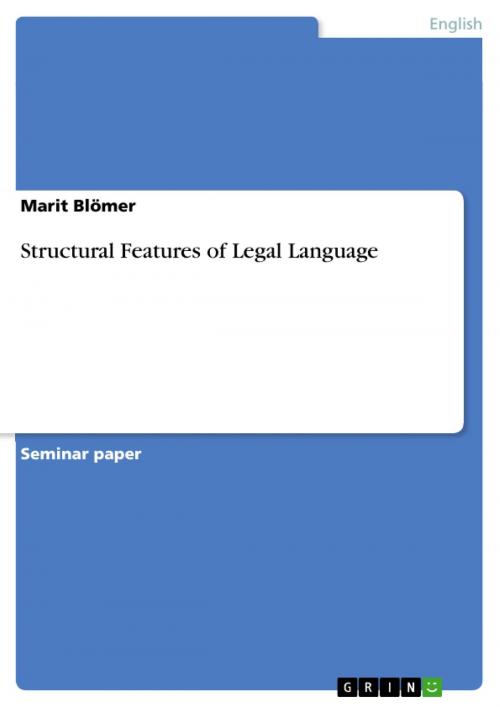| Author: | Marit Blömer | ISBN: | 9783668016828 |
| Publisher: | GRIN Verlag | Publication: | July 16, 2015 |
| Imprint: | GRIN Verlag | Language: | English |
| Author: | Marit Blömer |
| ISBN: | 9783668016828 |
| Publisher: | GRIN Verlag |
| Publication: | July 16, 2015 |
| Imprint: | GRIN Verlag |
| Language: | English |
Seminar paper from the year 2012 in the subject English Language and Literature Studies - Other, grade: 2,3, Ruhr-University of Bochum (Englisches Seminar), language: English, abstract: This paper deals with a specific English language - the legal language. I will focus on a particular aspect of this field - the characteristics of the structure of legal English. Therefore I will give an overview of the central structural features which are typical for legal language. Legal professionals strive for a precise explanation of facts. This aim forces them to use a certain kind of language patterns; including a high amount of definitions in legal texts, as well as numerous complex and ancient phrases deriving from Law French and plentiful enumerations which can all together form a single sentence covering several lines. Considering these special language patterns, the field of law, especially the legal language, becomes completely unapproachable for laymen, as it is almost impossible for them to follow legal discourse or understand legal contracts as well as laws and provisions. Even well-educated native speakers often find it hard to understand the language used in court. But the access to one's rights and duties is important in a community, so I decided to emphasize the differences between legal language and colloquial language and to show which structural features are characteristic for legal language. At first I will provide the reader with an overall definition of English as a special language, before I will have a closer look at legal English as a special language - the main topic of this essay. To show the structural features of legal language I will concentrate on three main characteristics in the structure of legal language - in my opinion the three most important ones, even though there are other important attributes as well. In a last step I will point out how these legal structures are used in real life. Therefore I will analyze a contract as well as a legislative text and think about ways to simplify the legal language used there to make it easier to follow such texts.
Seminar paper from the year 2012 in the subject English Language and Literature Studies - Other, grade: 2,3, Ruhr-University of Bochum (Englisches Seminar), language: English, abstract: This paper deals with a specific English language - the legal language. I will focus on a particular aspect of this field - the characteristics of the structure of legal English. Therefore I will give an overview of the central structural features which are typical for legal language. Legal professionals strive for a precise explanation of facts. This aim forces them to use a certain kind of language patterns; including a high amount of definitions in legal texts, as well as numerous complex and ancient phrases deriving from Law French and plentiful enumerations which can all together form a single sentence covering several lines. Considering these special language patterns, the field of law, especially the legal language, becomes completely unapproachable for laymen, as it is almost impossible for them to follow legal discourse or understand legal contracts as well as laws and provisions. Even well-educated native speakers often find it hard to understand the language used in court. But the access to one's rights and duties is important in a community, so I decided to emphasize the differences between legal language and colloquial language and to show which structural features are characteristic for legal language. At first I will provide the reader with an overall definition of English as a special language, before I will have a closer look at legal English as a special language - the main topic of this essay. To show the structural features of legal language I will concentrate on three main characteristics in the structure of legal language - in my opinion the three most important ones, even though there are other important attributes as well. In a last step I will point out how these legal structures are used in real life. Therefore I will analyze a contract as well as a legislative text and think about ways to simplify the legal language used there to make it easier to follow such texts.















